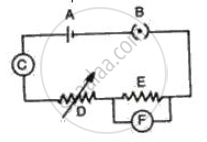Advertisements
Advertisements
Question
How should the two resistances of 2 ohms each be connected so as to produce an equivalent resistance of 1 ohm?
Solution
The two resistors of 2 Ω each should be connected in parallel combination to produce equivalent resistance of 1 Ω.
`1/R=1/R_1+1/R_2 `
`1/R=1/2+1/2`
or `1/R=2/2`
R=1 Ω
R = 1
Total resistance, R = 1 Ω
Resistance In parallel arangement is given by `
`1R=1R_1+1R_2`
`1R=12+12 or 1R=22 `
`R=1Ω `
APPEARS IN
RELATED QUESTIONS
An electrical bulb is marked 200V, 100W. Calculate the electrical resistance of its filament. If five such
bulbs are connected in series to a 200V supply, how much current will flow through them?
The graph between V and I for a conductor is a straight line passing through the origin.
Which law is illustrated by such a graph?
- Draw a V-I graph for a conductor obeying Ohm’s law.
- What does the slope of V–I graph for a conductor represent?
A wire of resistance 9 ohm having length 30 cm is tripled on itself. What is its new resistance?
Fig. represents the circuit used for the verification of ohm's law. Label the different parts from A and F. State the function of each.

Define Current density.
A metal rod of length 10 cm and a rectangular cross-section of 1 cm × `1/2` cm is connected to a battery across opposite faces. The resistance will be ______.
You are provided with a resistor, a key, an ammeter, a voltmeter, four cells of 1.5 V each and few connecting wires. Using circuit components, draw a labelled circuit diagram to show the setup to study Ohm's law.
State the relationship between potential difference (V) across the resistor and the current (I) flowing through it. Also draw V-I graph, taking V on the X-axis.
